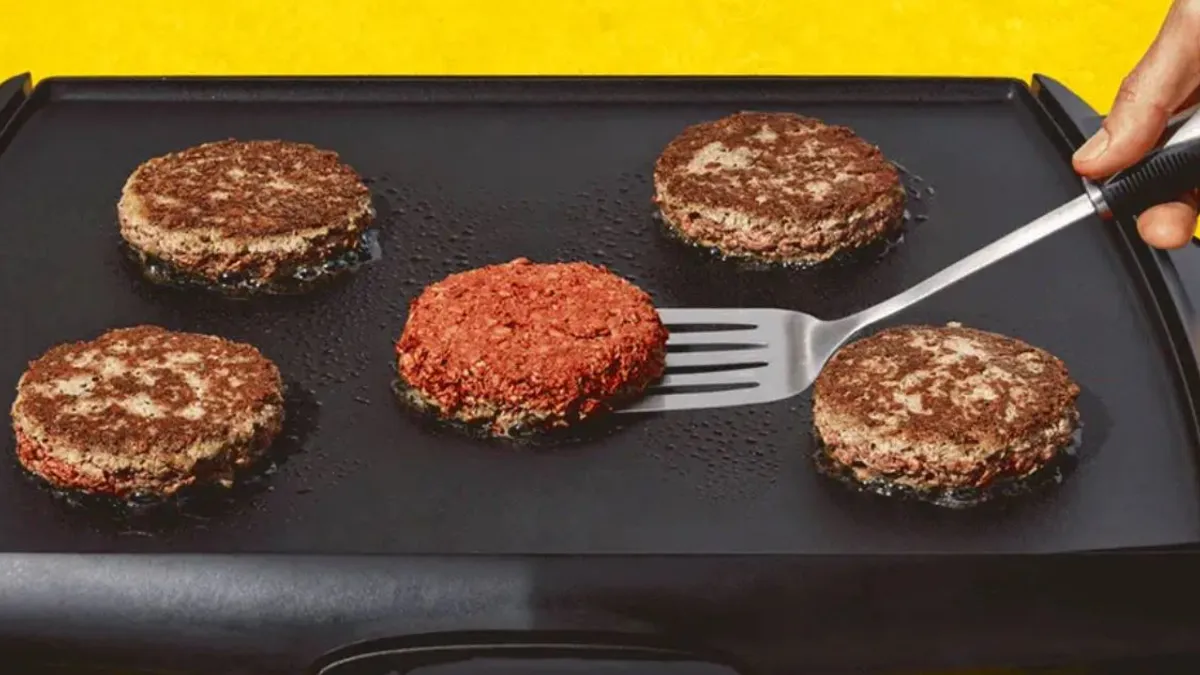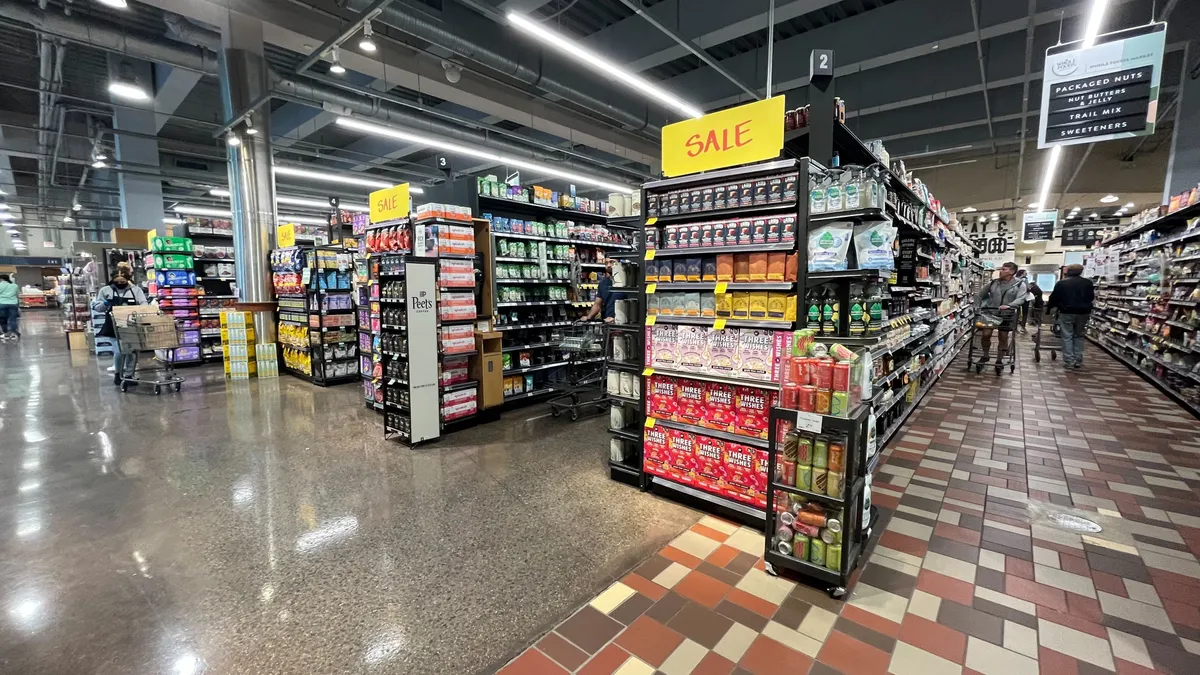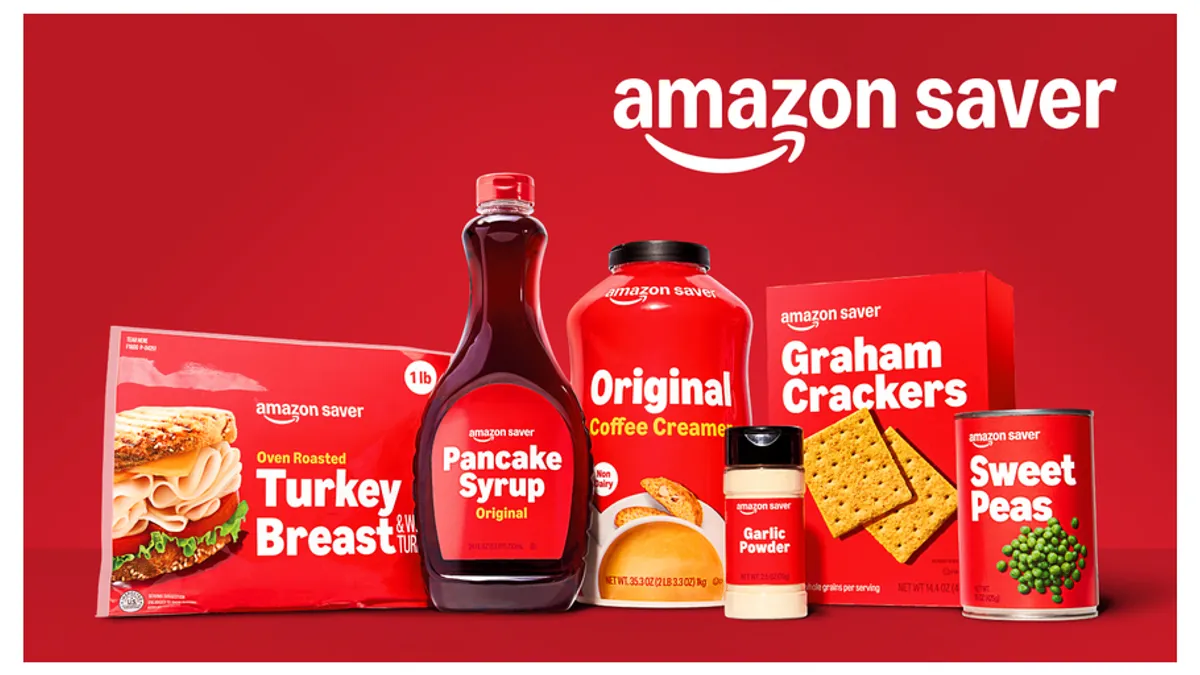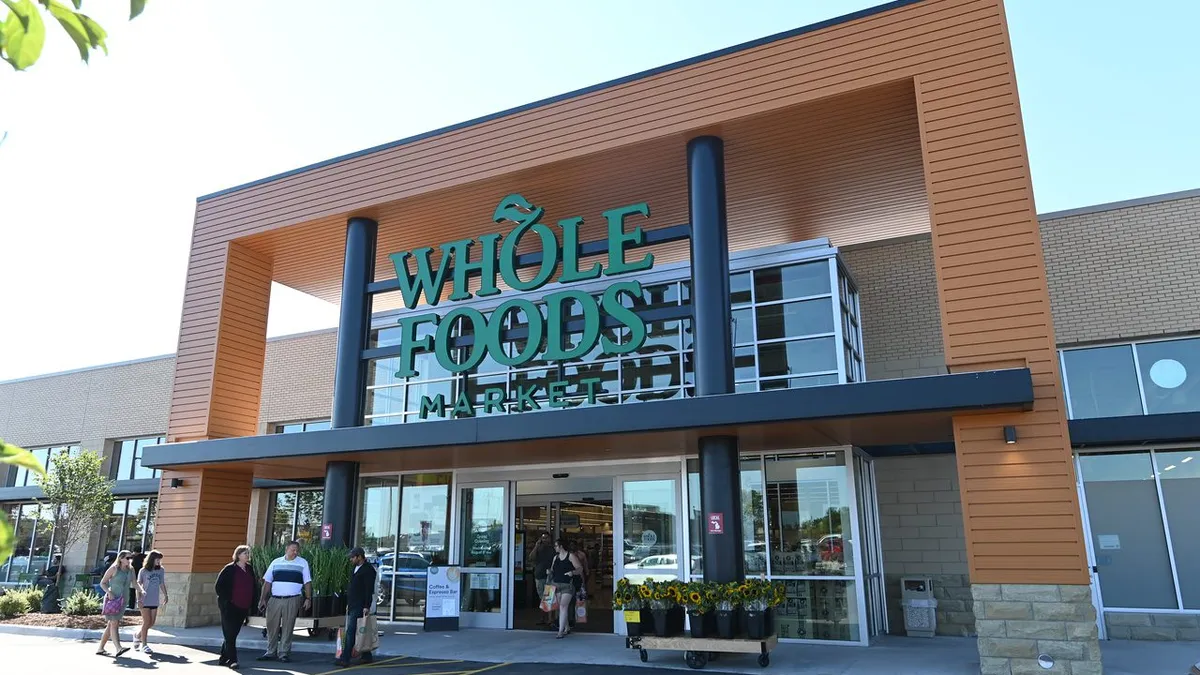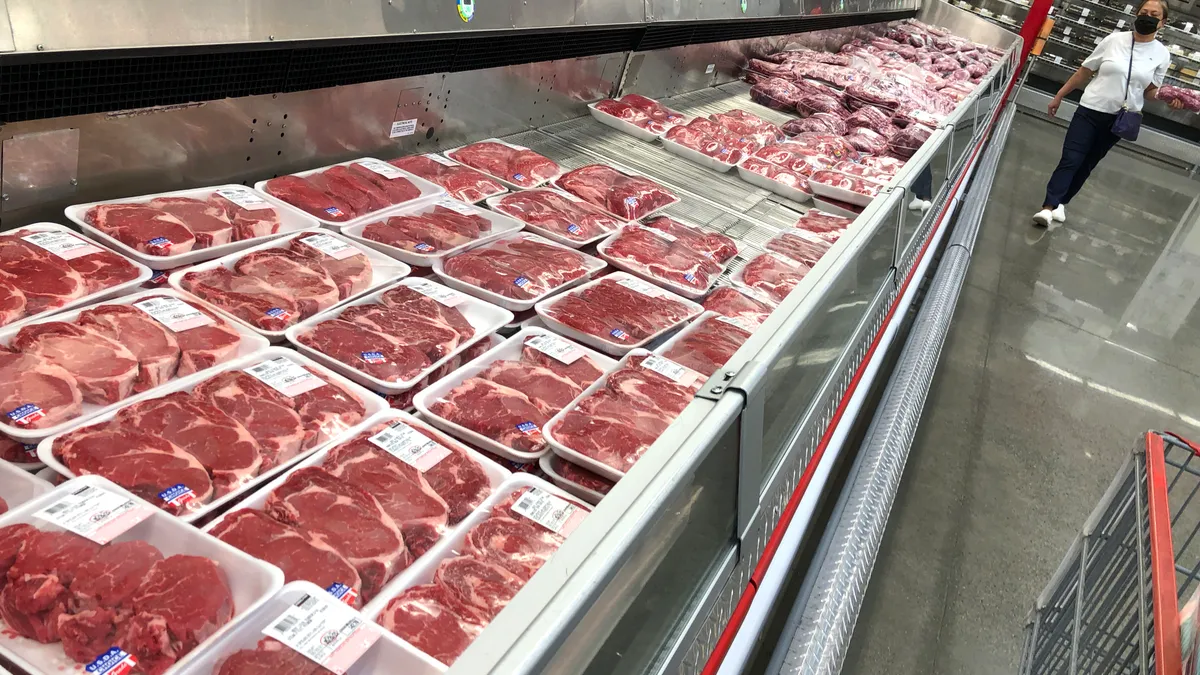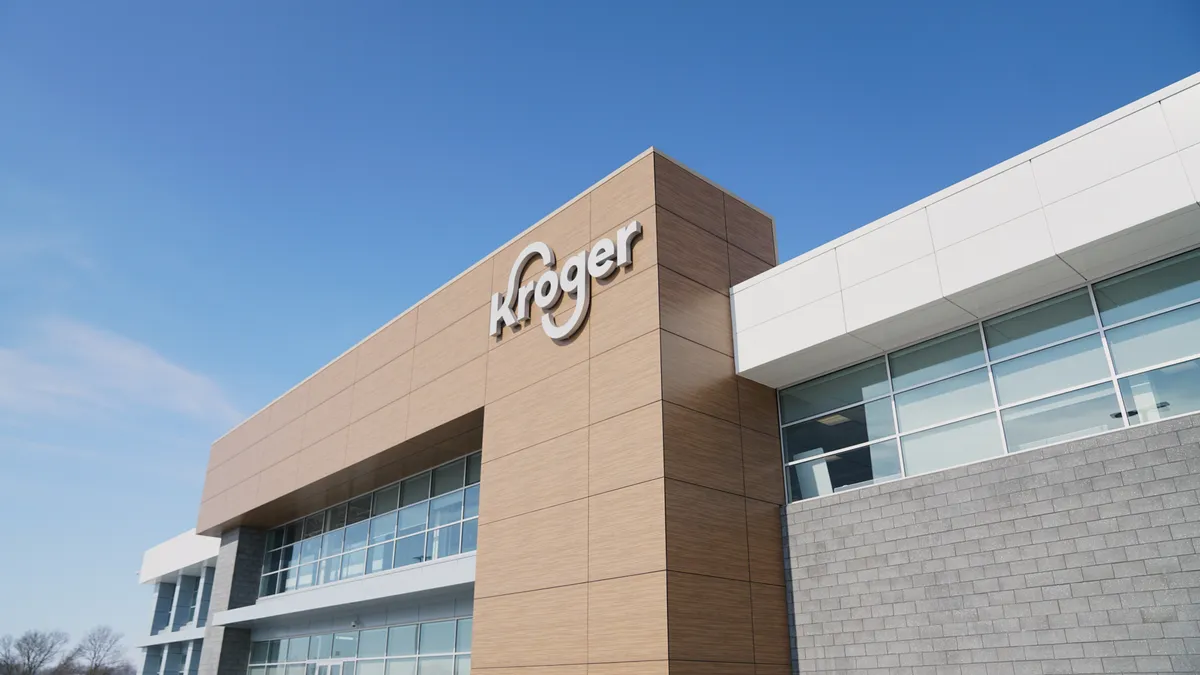CHICAGO — So what's the strategy behind Impossible Foods' latest plant-based innovation, Impossible Sausage? "The more we do, the closer we get to ubiquity, which is always the goal for us. We want to convert the world," J. Michael Melton, Impossible's technical sales and culinary manager, told Restaurant Dive on the National Restaurant Association Show's exhibitor floor. The product was developed with Little Caesars and launched Monday in three of the chain's locations for a limited time, marking Impossible's debut in the pizza category.
Though Impossible is arguably the front-runner in this emerging space thanks to its restaurant count and $750 million in funding, it was far from the only meat alternative manufacturer with something new to share at the show. Beyond Meat gave away samples of its Beyond Sausage and new beef chuck product, which has yet to hit the market. Kellogg's Morningstar Farms cooked up meat-free chorizo tacos, and Ocean Hugger served imitation eel made from eggplant and salmon made from carrots.
Plant-based food items have grown 54% over the last five years on operator menus, Technomic Executive Vice President of Business Development Pat Noone said at an NRA session. Industry analysts are in consensus that demand for vegan meat analogues signals a sea change for restaurant menus, not a passing novelty. And now that plant-based manufacturers have found staggering mainstream success in the burger category, brands are scrambling to stake their claim in new meat segments.
"The more we do, the closer we get to ubiquity, which is always the goal for us. We want to convert the world."

J. Michael Melton
Impossible Foods, technical sales and culinary manager
"I think anywhere that you see sausage you can imagine that that is where our lines are going," Heather Huestis, Impossible's vice president of marketing, told Restaurant Dive. "You can see that with our burger, which started with a patty and then looking at the versatility of that product and where else you can go with it."
But perhaps more interesting than the plant-based menu engineering shared from these brands is where they all said they were headed next: grocery retail. At present, Beyond Meat still enjoys a first-mover advantage in the supermarket space — it was the first plant-based product to be offered in the meat case — but an influx of rival products could shift the balance of power between these protein companies.
Brands align themselves with texture or nutrition
Euromonitor analyst Miranda Lambert told Restaurant Dive that the reason there has been space in plant-based meat for both Impossible and Beyond to thrive is because they approached the market from different directions — foodservice and retail distribution, respectively.
With Impossible gearing up to enter grocery with its Impossible Burger 2.0 recipe, which launched in March and can be prepared in any way that traditional ground beef can be cooked, the differences between the two products may be more closely scrutinized by consumers.
"They offer slightly different products. I don't know that they are perfect substitutes [for one another]," Lambert said.
At the NRA Show, for example, the Beyond Meat team argued its products are the cleanest, most nutritious plant-based meat options because they contain no soy, gluten or GMOs.
"We have the lowest barrier to entry … not just for restaurateurs to have a streamlined menu but also for people who are cooking at home," Beyond Meat senior communications director Allison Aronoff said. "You don’t want to have to prepare five different dishes to accommodate the dietary needs of your family or friends. You want one center-of-the-plate protein solution."
Meanwhile, Impossible and newcomer Before the Butcher focused mainly on their products' texture, mouthfeel and colorization, which are created using soy proteins. Before the Butcher was founded by Beyond Meat veteran Danny O'Malley and will enter grocery stores next month.
O'Malley told Restaurant Dive he hasn’t been able to find any plant-based ingredient that can top soy when it comes to mimicking the complex textures of different meats found in his brand’s chicken, beef tip and pulled pork products. He said that both consumer concern over soy and industry perception of that concern are overblown, and what diners are more interested in is a meaty texture than what’s found on the ingredient label.
It’s unclear, however, whether claims about mouthfeel or nutrition will have the most pull with consumers when these products can be compared side by side in the grocery aisle.
There's room for newcomers, but big names are powerful
Impossible’s burger shortages — which the company warned restaurant clients of following its chainwide expansion with Burger King — and the supply risks outlined in Beyond Meat’s IPO could leave room for smaller plant-based meat brands to gain traction both in retail and foodservice.
Though diner frustrations over scarcity of their favorite plant-based alternative poses only a temporary loss for restaurants due to the strength of demand, Lambert said, diners will likely be looking for backup brands to be safe. This is because consumers have developed a taste for faux meat specifically, not just vegetarian or vegan options, and it would be challenging for restaurants to develop something competitive in-house.
"...Now is the time. The world is your plant-based oyster."

J. Michael Melton
Technical sales and culinary manager, Impossible Foods,
"The [replacement product] will be important because it reflects on the restaurant," she said. "If you choose a backup that falls apart… there will be frustration."
Impossible considers the adaptability of its 2.0 product, which was redesigned to withstand high heat and open flames to make the product more forgiving for chefs and home cooks, its point of differentiation in the growing plant-based meat market.
"Veggie patties of the past were basically a re-heatable puck," Melton said. "The dynamic nature of our product allows it to be used in any way that you can use conventional ground meat. You can use our bulk product to do crumbles, meatballs, meat loaf, lasagna. Ultimately, you take what we offer and utilize it in any way that you would use traditional ground beef."
Aside from the advanced product design that heavyweights like Impossible and Beyond offer, the level of brand awareness they have garnered over the years will likely keep them competitive in grocery and foodservice despite new competition.
"Leveraging a brand will certainly make a difference… and if you do I assure you will probably have anywhere between four and six times the basket lift of what you were selling before as a meat alternative option," Beyond Meat regional sales manager Tim Smith said in an NRA session.
Ultimately, however, the influx of plant-based meat innovation in restaurants and retail is beneficial for brands that are in or are entering the market, Aronoff said.
"The great thing is that we're all in support of the same mission, so in our mind a rising tide raises all boats, which is great for all the players in this space," she said.
Melton echoed this sentiment.
"We support everybody in the plant-based space and really want everyone to succeed because now is the time.. The world is your plant-based oyster," he said.
Still, the future of this segment depends on these brands' ability to be cost competitive with traditional meat products, a goal that is being undermined by insufficient production capacity from major players, Lambert said.
"The goal for both [Impossible and Beyond Meat] was that vegan options would taste like meat and eventually be the same price if not cheaper than meat to make a difference climate-wise," she said. "The only way this is going to happen is if they can keep price down, and this huge shift in demand would generally come with an increased price point … it will be interesting to see how they're able to deliver around that."



